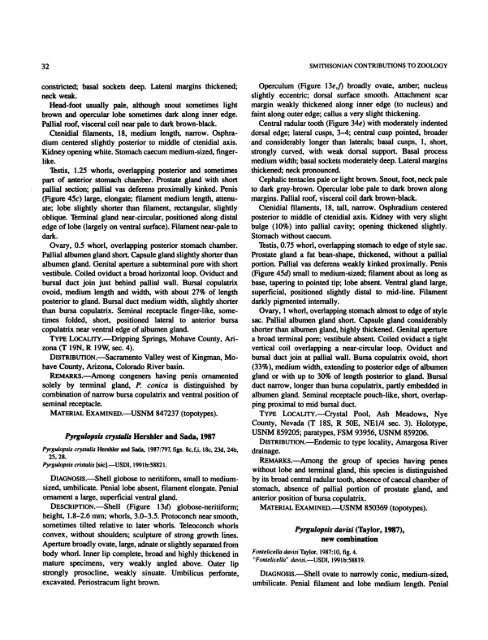A Review of the North American Freshwater Snail Genus Pyrgulopsis
A Review of the North American Freshwater Snail Genus Pyrgulopsis
A Review of the North American Freshwater Snail Genus Pyrgulopsis
You also want an ePaper? Increase the reach of your titles
YUMPU automatically turns print PDFs into web optimized ePapers that Google loves.
32<br />
constricted; basal sockets deep. Lateral margins thickened;<br />
neck weak.<br />
Head-foot usually pale, although snout sometimes light<br />
brown and opercular lobe sometimes dark along inner edge.<br />
Pallial ro<strong>of</strong>, visceral coil near pale to dark brown-black.<br />
Ctenidial filaments, 18, medium length, narrow. Osphradium<br />
centered slightly posterior to middle <strong>of</strong> ctenidial axis.<br />
Kidney opening white. Stomach caecum medium-sized, fingerlike.<br />
Testis, 1.25 whorls, overlapping posterior and sometimes<br />
part <strong>of</strong> anterior stomach chamber. Prostate gland with short<br />
pallial section; pallial vas deferens proximally kinked. Penis<br />
(Figure 45c) large, elongate; filament medium length, attenuate;<br />
lobe slightly shorter than filament, rectangular, slightly<br />
oblique. Terminal gland near-circular, positioned along distal<br />
edge <strong>of</strong> lobe (largely on ventral surface). Filament near-pale to<br />
dark.<br />
Ovary, 0.5 whorl, overlapping posterior stomach chamber.<br />
Pallial albumen gland short Capsule gland slightly shorter than<br />
albumen gland. Genital aperture a subterminal pore with short<br />
vestibule. Coiled oviduct a broad horizontal loop. Oviduct and<br />
bursal duct join just behind pallial wall. Bursal copulatrix<br />
ovoid, medium length and width, with about 27% <strong>of</strong> length<br />
posterior to gland. Bursal duct medium width, slightly shorter<br />
than bursa copulatrix. Seminal receptacle finger-like, sometimes<br />
folded, short, positioned lateral to anterior bursa<br />
copulatrix near ventral edge <strong>of</strong> albumen gland.<br />
TYPE LOCALITY.—Dripping Springs, Mohave County, Arizona<br />
(T 19N, R 19W, sec. 4).<br />
DISTRIBUTION.—Sacramento Valley west <strong>of</strong> Kingman, Mohave<br />
County, Arizona, Colorado River basin.<br />
REMARKS.—Among congeners having penis ornamented<br />
solely by terminal gland, P. cornea is distinguished by<br />
combination <strong>of</strong> narrow bursa copulatrix and ventral position <strong>of</strong><br />
seminal receptacle.<br />
MATERIAL EXAMINED.—USNM 847237 (topotypes).<br />
<strong>Pyrgulopsis</strong> crystalis Hershler and Sada, 1987<br />
<strong>Pyrgulopsis</strong> crystalis Hershler and Sada, 1987:797, figs. 8c,f,i, 18c, 23d, 24b,<br />
25.28.<br />
<strong>Pyrgulopsis</strong> cristalis [sic].—USDI, 1991b:58821.<br />
DIAGNOSIS.—Shell globose to neritiform, small to mediumsized,<br />
umbilicate. Penial lobe absent, filament elongate. Penial<br />
ornament a large, superficial ventral gland.<br />
DESCRIPTION.—Shell (Figure 13d) globose-neritiform;<br />
height, 1.8-2.6 mm; whorls, 3.0-3.5. Protoconch near smooth,<br />
sometimes tilted relative to later whorls. Teleoconch whorls<br />
convex, without shoulders; sculpture <strong>of</strong> strong growth lines.<br />
Aperture broadly ovate, large, adnate or slightly separated from<br />
body whorl. Inner lip complete, broad and highly thickened in<br />
mature specimens, very weakly angled above. Outer lip<br />
strongly prosocline, weakly sinuate. Umbilicus perforate,<br />
excavated. Periostracum light brown.<br />
SMITHSONIAN CONTRIBUTIONS TO ZOOLOGY<br />
Operculum (Figure I3e,f) broadly ovate, amber, nucleus<br />
slightly eccentric; dorsal surface smooth. Attachment scar<br />
margin weakly thickened along inner edge (to nucleus) and<br />
faint along outer edge; callus a very slight thickening.<br />
Central radular tooth (Figure 34e) with moderately indented<br />
dorsal edge; lateral cusps, 3-4; central cusp pointed, broader<br />
and considerably longer than laterals; basal cusps, 1, short,<br />
strongly curved, with weak dorsal support. Basal process<br />
medium width; basal sockets moderately deep. Lateral margins<br />
thickened; neck pronounced.<br />
Cephalic tentacles pale or light brown. Snout, foot, neck pale<br />
to dark gray-brown. Opercular lobe pale to dark brown along<br />
margins. Pallial ro<strong>of</strong>, visceral coil dark brown-black.<br />
Ctenidial filaments, 18, tall, narrow. Osphradium centered<br />
posterior to middle <strong>of</strong> ctenidial axis. Kidney with very slight<br />
bulge (10%) into pallial cavity; opening thickened slightly.<br />
Stomach without caecum.<br />
Testis, 0.75 whorl, overlapping stomach to edge <strong>of</strong> style sac.<br />
Prostate gland a fat bean-shape, thickened, without a pallial<br />
portion. Pallial vas deferens weakly kinked proximally. Penis<br />
(Figure 45d) small to medium-sized; filament about as long as<br />
base, tapering to pointed tip; lobe absent Ventral gland large,<br />
superficial, positioned slightly distal to mid-line. Filament<br />
darkly pigmented internally.<br />
Ovary, 1 whorl, overlapping stomach almost to edge <strong>of</strong> style<br />
sac. Pallial albumen gland short. Capsule gland considerably<br />
shorter than albumen gland, highly thickened. Genital aperture<br />
a broad terminal pore; vestibule absent. Coiled oviduct a tight<br />
vertical coil overlapping a near-circular loop. Oviduct and<br />
bursal duct join at pallial wall. Bursa copulatrix ovoid, short<br />
(33%), medium width, extending to posterior edge <strong>of</strong> albumen<br />
gland or with up to 30% <strong>of</strong> length posterior to gland. Bursal<br />
duct narrow, longer than bursa copulatrix, partly embedded in<br />
albumen gland. Seminal receptacle pouch-like, short overlapping<br />
proximal to mid bursal duct.<br />
TYPE LOCALITY.—Crystal Pool, Ash Meadows, Nye<br />
County, Nevada (T 18S, R 50E, NE1/4 sec. 3). Holotype,<br />
USNM 859205; paratypes, FSM 93956, USNM 859206.<br />
DISTRIBUTION.—Endemic to type locality, Amargosa River<br />
drainage.<br />
REMARKS.—Among <strong>the</strong> group <strong>of</strong> species having penes<br />
without lobe and terminal gland, this species is distinguished<br />
by its broad central radular tooth, absence <strong>of</strong> caecal chamber <strong>of</strong><br />
stomach, absence <strong>of</strong> pallial portion <strong>of</strong> prostate gland, and<br />
anterior position <strong>of</strong> bursa copulatrix.<br />
MATERIAL EXAMINED.—USNM 850369 (topotypes).<br />
<strong>Pyrgulopsis</strong> davisi (Taylor, 1987),<br />
new combination<br />
Fontelicella davisi Taylor, 1987:10, fig. 4.<br />
"Fontelicella" davisi.—USDI, 1991b:58819.<br />
DIAGNOSIS.—Shell ovate to narrowly conic, medium-sized,<br />
umbilicate. Penial filament and lobe medium length. Penial

















